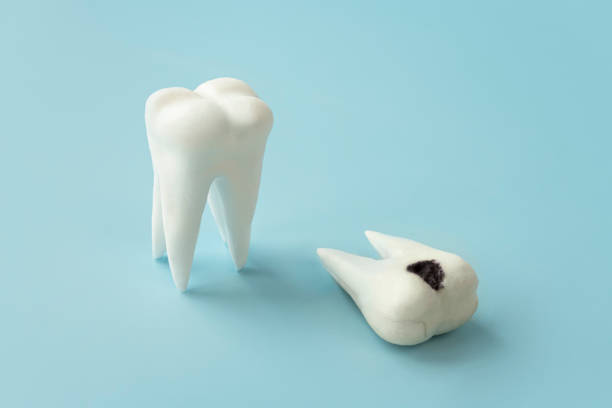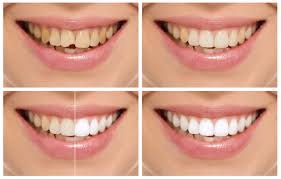
Tooth decay
what is Tooth decay?
Tooth decay, also referred to as dental caries or cavities, is a prevalent oral health concern affecting people of all ages. It occurs when acids generated by bacteria in the mouth erode the tooth’s hard outer layer, known as enamel. Thankfully, there are multiple effective treatments available to restore both the health and functionality of your teeth.


Tooth Decay: Before and After Treatment
Tooth decay, also known as dental caries, is a common oral health issue caused by bacteria breaking down the tooth enamel. Left untreated, it can lead to cavities, pain, and more severe dental problems. However, modern dentistry offers effective solutions to restore a decayed tooth’s health and function.
Before Treatment: Signs and Symptoms
Before treatment, patients may experience:
- Tooth Sensitivity: A sharp pain when consuming hot, cold, or sweet foods.
- Visible Cavities: Small holes or dark spots on the tooth surface.
- Toothache: Persistent or occasional pain without any apparent cause.
- Bad Breath: Due to bacterial buildup in the mouth.
- Gum Swelling: Mild inflammation or swelling around the affected tooth.
Treatment Options for Tooth Decay
- 1. Fluoride Treatment: For early-stage decay, a professional fluoride treatment can help repair the enamel.
- Dental Fillings: If decay has created a cavity, the dentist will remove the decayed part and fill it with a durable material like composite resin or amalgam.
- Crowns: For extensive decay that has weakened the tooth structure, a dental crown may be needed to cover and protect the remaining tooth.
- Root Canal Therapy: If the decay has reached the pulp, a root canal is performed to remove the infected tissue and seal the tooth.
- Tooth Extraction: In cases of severe decay where the tooth is beyond repair, extraction may be necessary, followed by a dental implant or bridge to restore function.

After Treatment: What to Expect
After the treatment, patients will notice:
- Relief from Pain: Discomfort and sensitivity should subside almost immediately after treatment.
- Improved Appearance: Fillings and crowns restore the tooth’s natural look, often matching the color and shape of your natural teeth.
- Better Functionality: You can chew and speak comfortably without the pain caused by decay.
- Enhanced Oral Health: Regular dental visits and proper hygiene practices help prevent future decay and maintain the results of the treatment.
Before and After Care Tips
- Before Treatment: Avoid eating hard or sticky foods that could worsen the decay. Maintain good oral hygiene with regular brushing and flossing, and use fluoride toothpaste.
- After Treatment: Follow the dentist’s instructions carefully, avoid chewing on hard foods for a few days, and maintain regular dental check-ups to ensure long-lasting results.
Treatments for Tooth Decay
- Fluoride Treatments
- Fluoride is a mineral that helps strengthen tooth enamel and can reverse early signs of tooth decay. Fluoride treatments are often recommended for individuals at high risk of cavities. The treatment can be done in the dentist’s office using a high-concentration fluoride gel, foam, varnish, or rinse applied directly to the teeth. Regular use of fluoride toothpaste and drinking fluoridated water can also help prevent decay.
- Dental Fillings
- When a cavity has formed, the most common treatment is a dental filling. During this procedure, the decayed portion of the tooth is removed, and the cavity is filled with a material like composite resin, amalgam, gold, or porcelain. Composite resins, which are tooth-colored, offer a more natural appearance and bond directly to the tooth structure, providing added support.
- Root Canal Therapy
- If tooth decay extends to the inner pulp of the tooth, leading to infection or severe pain, root canal therapy might be required.
- This procedure involves removing the infected or damaged pulp, thoroughly cleaning the root canal, and sealing it to prevent future infections. To restore the tooth’s shape, strength, and function, a crown may be placed on it afterward.
- Crowns
- A crown is a custom-designed cap placed over the damaged tooth to restore its appearance and function. Crowns can be made from materials like porcelain, ceramic, or metal and are designed to blend perfectly with the color and shape of your natural teeth.
- Dental Sealants
- Dental sealants are a protective coating applied to the chewing surfaces of the back teeth (molars) to prevent food and bacteria from getting trapped in the grooves, where decay is most likely to occur. Sealants are especially beneficial for children and teenagers but can also be effective for adults.
- Inlays and Onlays
- For moderate decay that is too extensive for a filling but not severe enough for a crown, inlays and onlays offer an ideal solution. These custom-crafted restorations, made from materials like porcelain, composite resin, or gold, are bonded to the damaged area of the tooth, providing a durable and long-lasting repair.
- Tooth Extraction
- In cases where the tooth is severely decayed and cannot be saved, extraction may be necessary. After an extraction, options like dental implants, bridges, or dentures can help restore function and aesthetics.
- Preventive Measures
- Regular dental check-ups, proper brushing and flossing, a balanced diet low in sugar, and avoiding acidic beverages can all help protect your teeth from decay. Additionally, using a fluoride mouthwash and chewing sugar-free gum can contribute to maintaining a healthy oral environment.
Tooth Decay: Before and After Treatment
Advantages of Basal Implants
Immediate Functionality: Basal implants are designed for immediate loading, allowing patients to regain functionality and aesthetics almost instantly after the procedure.
Minimal Bone Requirements: Unlike conventional implants, basal implants do not require extensive bone grafting procedures, making them ideal for patients with significant bone loss or those who want to avoid additional surgeries.
Reduced Treatment Time: The entire treatment process with basal implants is faster, often completed within a few days, compared to the months required for traditional implants.
High Success Rate: Due to their placement in the highly stable basal bone, these implants have a high success rate, even in complex cases.
Cost-Effective: By eliminating the need for bone grafting and reducing overall treatment time, basal implants can be more cost-effective compared to conventional implant solutions.
Conclusion
Tooth decay is a widespread but preventable dental issue that can impact individuals of any age. Fortunately, modern dentistry provides a range of effective treatments—such as fluoride treatments, fillings, root canals, and crowns—to restore both the health and functionality of your teeth.
F.A.Q.
Srikanth Dental
Dental implants are artificial tooth roots, typically made from titanium, that are surgically placed into the jawbone to support a replacement tooth, bridge, or denture.
Most patients report minimal discomfort during the procedure, as local anesthesia is used. Post-operative pain can usually be managed with over-the-counter pain medications and ice packs.
- The entire process can take several months, involving multiple stages:
- Initial consultation and planning
- Implant placement (2-3 months healing time for osseointegration)
Abutment placement and crown fitting
- While dental implants are generally safe, potential risks include infection, implant failure, nerve damage, or sinus problems. Proper planning and skilled execution can minimize these risks.
- Care for dental implants involves:
- Regular brushing and flossing
- Using a soft-bristled toothbrush and non-abrasive toothpaste
- Routine dental check-ups and professional cleanings
- Avoiding smoking and excessive alcohol consumption
